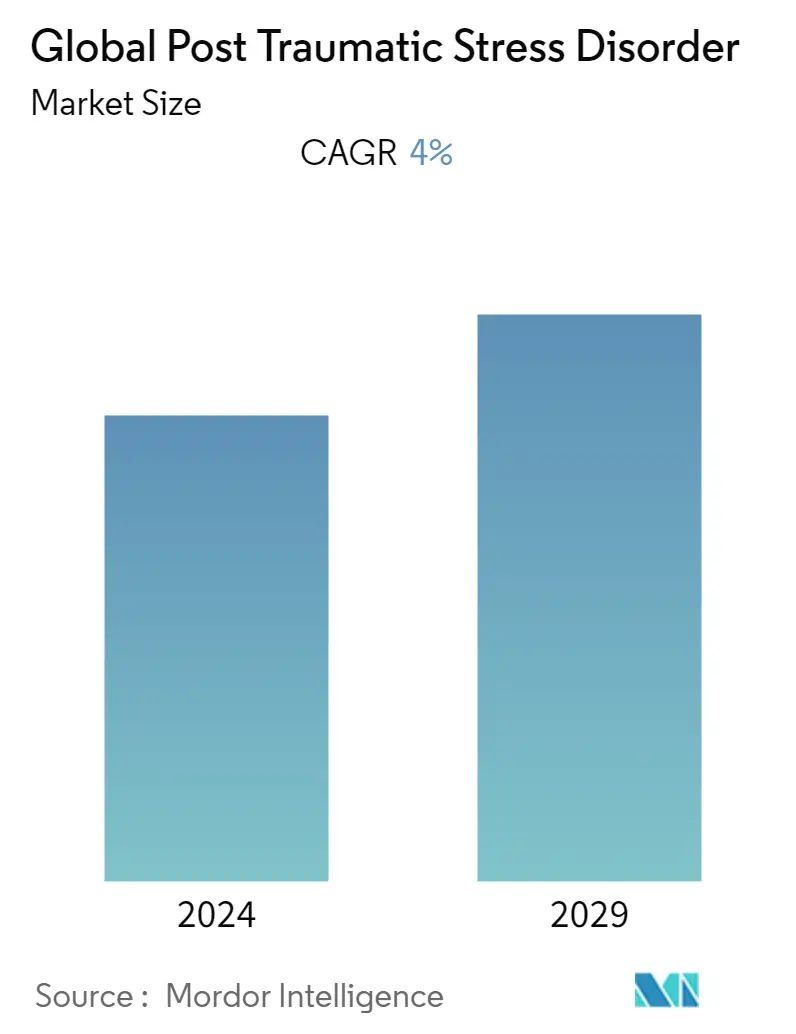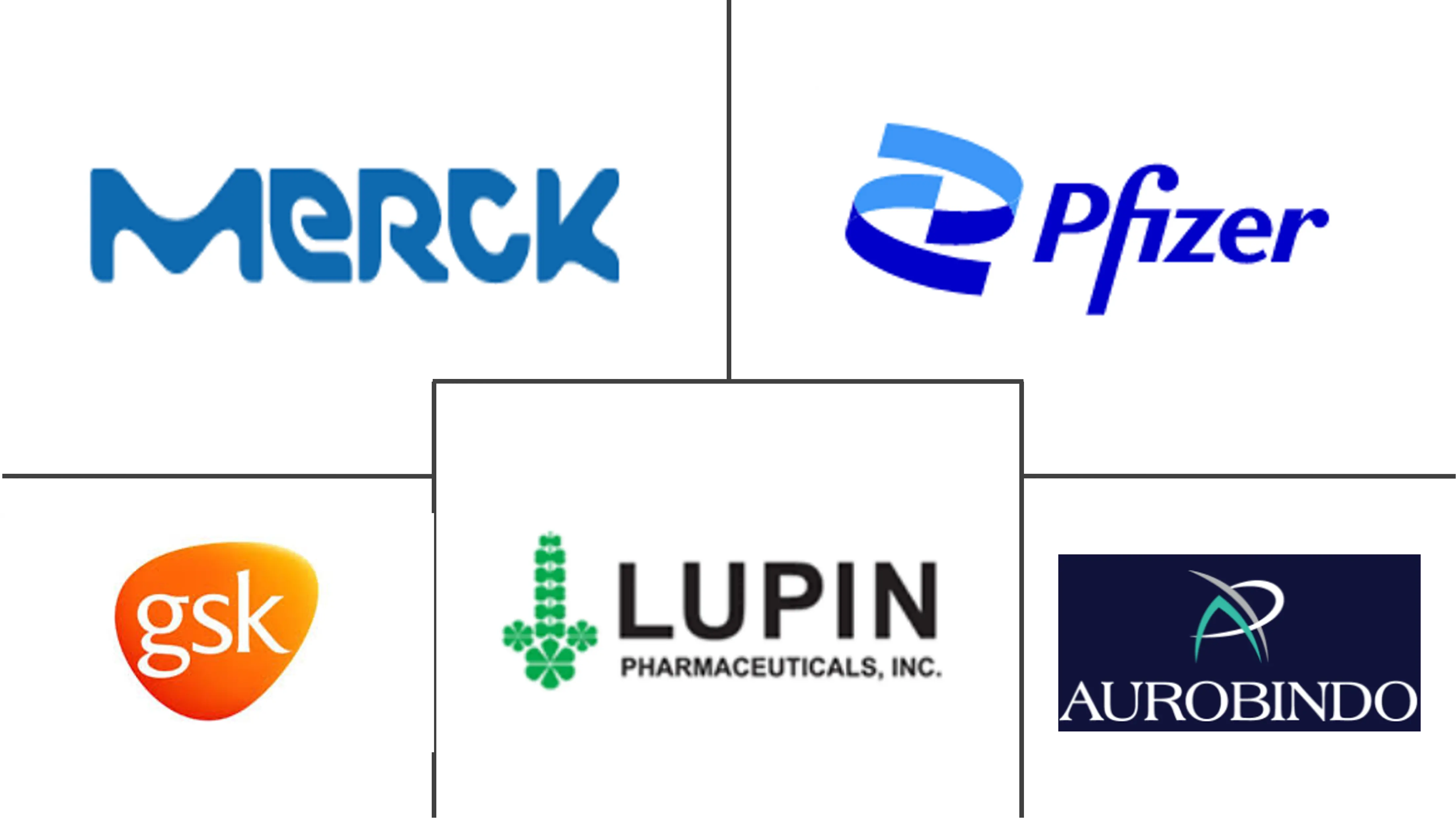Market Size of Global Post Traumatic Stress Disorder

| Study Period | 2019 - 2029 |
| Base Year For Estimation | 2023 |
| CAGR | 4.00 % |
| Fastest Growing Market | Asia-Pacific |
| Largest Market | North America |
| Market Concentration | Medium |
Major Players
*Disclaimer: Major Players sorted in no particular order |
Post Traumatic Stress Disorder Market Analysis
The post traumatic stress disorder treatment market is expected to register a CAGR of more than 4% over the forecast period (2022-2027).
The COVID-19 pandemic is an unprecedented health concern that has significantly impacted the posttraumatic stress disorder (PTSD) treatment market. There are several studies conducted that indicate that COVID-19 increases the risk of PTSD, and this has led to an increase in demand for PTSD treatment. For instance, an article titled, "COVID19 and Posttraumatic Stress Disorder: The Perfect 'Storm' for Mental Health (Review)" published in August 2021 demonstrated that COVID-19 has a substantial impact on mental health and poses a significant risk to the development of trauma-related disorders, including PTSD among individuals who are most vulnerable, such as children, adolescents and COVID-19 survivors. Additionally, as per an article titled, "Posttraumatic Stress Disorder in Patients After Severe COVID-19 Infection", published in February 2021, a cross-sectional study found a PTSD prevalence of 30.2% after acute COVID-19 infection, which is in line with findings in survivors of the previous coronavirus illnesses compared with findings reported after other types of collective traumatic events. Such studies indicate that the demand for PTSD treatment boosted amid the pandemic. Thus, the COVID-19 pandemic has positively impacted market growth.
The growth of the market can be attributed to the factors such as the increasing burden of post-traumatic stress disorder (PTSD) worldwide, the rise in the number of clinical trials pertaining to PTSD treatment as well as increasing research and development of novel therapies and drugs for PTSD.
The increasing burden of post-traumatic stress disorder is driving the demand for treatment that is majorly contributing to the market growth. As per the article titled, "Global Burden of Posttraumatic Stress Disorder and Major Depression in Countries Affected by the War: a Systematic Review and Meta-analysis" published in July 2021 reported that out of twenty-two surveys for PTSD, 13 surveys for major depression (MD) and six surveys on the comorbidity of post-traumatic stress disorder and MD were included. As per the study, random effects meta-analyses yielded a point prevalence of 26.51% for post-traumatic stress disorder. The study also stated that the extrapolation yielded 316 million adult war survivors globally who suffered frompost-traumatic stress disorder and/or Major depression. Thus, the statistics from the study indicate the rising demand for post-traumatic stress disorder treatment.
Additionally, as per an April 2022 update by SANE Australia, in Australia, around 1-2% of adults experience post-traumatic stress disorder each year, while approximately 12% experience PTSD in their lifetime. This further indicates the significantly growing demand for post-traumatic stress disorder treatment.
However, the rise in the number of clinical trials is also contributing to the market growth. For instance, in June 2020, SIU School of Medicine launched a clinical trial to study the safety and efficacy of an investigational drug for post-traumatic stress disorder. Furthermore, in June 2021, ANANDA Scientific Inc., biotech pharmaceutical company, and NYU Grossman School of Medicine today reported the first patient was enrolled in a clinical trial evaluating Nantheia A1002N5S, an investigational drug using cannabidiol in ANANDA's proprietary Liquid Structure delivery technology as a treatment for Post-Traumatic Stress Disorder (PTSD) symptoms and Neurocognitive Impairment in patients with post-traumatic stress disorder and with post-traumatic stress disordercomorbid with Traumatic Brain Injury (TBI). Thus, due to the above-mentioned factors, the market is expected to grow significantly over the forecast period.
However, side effects associated with post-traumatic stress disorder treatment and the high cost of the treatment are the major factors hindering the market growth.
Post Traumatic Stress Disorder Industry Segmentation
As per the scope of the report, post-traumatic stress disorder (PTSD) is referred to as a mental health condition that's triggered by a terrifying event, either experiencing it or witnessing it. The treatment of PTSD includes the use of certain medications. The Post Traumatic Stress Disorder Treatment market is segmented by Drug Class (Antidepressants, Anti-anxiety drugs, Antipsychotics, and Other Drug Classes), By Patient (Adult and Children), By Distribution Channel (Hospital Pharmacies, Retail Pharmacies, and Other Distribution Channels) and Geography (North America, Europe, Asia-Pacific, Middle-East and Africa, and South America). The market report also covers the estimated market sizes and trends for 17 different countries across major regions globally. The report offers the value (in USD million) for the above segments.
| By Drug Class | |
| Antidepressants | |
| Anti-anxiety Drugs | |
| Antipsychotics | |
| Other Drug Classes |
| By Patient | |
| Adult | |
| Children |
| By Distribution Channel | |
| Hospital Pharmacies | |
| Retail Pharmacies | |
| Other Distribution Channel |
| Geography | ||||||||
| ||||||||
| ||||||||
| ||||||||
| ||||||||
|
Global Post Traumatic Stress Disorder Size Summary
The post-traumatic stress disorder (PTSD) treatment market is poised for significant growth, driven by an increasing global burden of PTSD and the heightened demand for effective treatments. The COVID-19 pandemic has further exacerbated this demand, as studies indicate a rise in PTSD cases among vulnerable populations, including children, adolescents, and COVID-19 survivors. This surge in demand is supported by a growing number of clinical trials and research initiatives focused on developing novel therapies and drugs for PTSD. The market is characterized by the presence of key players who are actively engaging in strategic partnerships, mergers, and acquisitions to enhance their product offerings and market presence. Antidepressants, particularly selective serotonin reuptake inhibitors (SSRIs), are expected to maintain a significant share in the market, with ongoing developments in drug formulations and delivery technologies.
In North America, particularly the United States, the market is experiencing robust growth due to the high prevalence of PTSD and the active involvement of established market players in research and development activities. The increasing awareness of PTSD and its treatment options is further propelling market expansion. The competitive landscape is marked by the presence of several global and international players, such as Lupin Limited, Pfizer Inc., and GlaxoSmithKline plc, who are leveraging innovative strategies to capture market share. Despite challenges such as treatment side effects and high costs, the market is expected to witness substantial growth over the forecast period, driven by advancements in clinical research and the development of effective treatment modalities.
Global Post Traumatic Stress Disorder Market Size - Table of Contents
-
1. MARKET DYNAMICS
-
1.1 Market Overview
-
1.2 Market Drivers
-
1.2.1 Growing Burden of Post-Traumatic Stress Disorder (PTSD) Worldwide
-
1.2.2 Rise in Number of Clinical Trials Pertaining to Post-Traumatic Stress Disorder (PTSD) Treatment
-
1.2.3 Increasing Research and Development for Novel Therapies and Drugs
-
-
1.3 Market Restraints
-
1.3.1 Side Effects Associated with Post-Traumatic Stress Disorder Treatment
-
1.3.2 Hight Cost of the Treatment
-
-
1.4 Porter's Five Forces Analysis
-
1.4.1 Threat of New Entrants
-
1.4.2 Bargaining Power of Buyers/Consumers
-
1.4.3 Bargaining Power of Suppliers
-
1.4.4 Threat of Substitute Products
-
1.4.5 Intensity of Competitive Rivalry
-
-
-
2. MARKET SEGMENTATION (Market Size by Value - USD million)
-
2.1 By Drug Class
-
2.1.1 Antidepressants
-
2.1.2 Anti-anxiety Drugs
-
2.1.3 Antipsychotics
-
2.1.4 Other Drug Classes
-
-
2.2 By Patient
-
2.2.1 Adult
-
2.2.2 Children
-
-
2.3 By Distribution Channel
-
2.3.1 Hospital Pharmacies
-
2.3.2 Retail Pharmacies
-
2.3.3 Other Distribution Channel
-
-
2.4 Geography
-
2.4.1 North America
-
2.4.1.1 United States
-
2.4.1.2 Canada
-
2.4.1.3 Mexico
-
-
2.4.2 Europe
-
2.4.2.1 Germany
-
2.4.2.2 United Kingdom
-
2.4.2.3 France
-
2.4.2.4 Italy
-
2.4.2.5 Spain
-
2.4.2.6 Rest of Europe
-
-
2.4.3 Asia-Pacific
-
2.4.3.1 China
-
2.4.3.2 Japan
-
2.4.3.3 India
-
2.4.3.4 Australia
-
2.4.3.5 South Korea
-
2.4.3.6 Rest of Asia-Pacific
-
-
2.4.4 Middle-East and Africa
-
2.4.4.1 GCC
-
2.4.4.2 South Africa
-
2.4.4.3 Rest of Middle-East and Africa
-
-
2.4.5 South America
-
2.4.5.1 Brazil
-
2.4.5.2 Argentina
-
2.4.5.3 Rest of South America
-
-
-
Global Post Traumatic Stress Disorder Market Size FAQs
What is the current Global Post Traumatic Stress Disorder Market size?
The Global Post Traumatic Stress Disorder Market is projected to register a CAGR of 4% during the forecast period (2024-2029)
Who are the key players in Global Post Traumatic Stress Disorder Market?
Lupin Limited , Pfizer Inc., Aurobindo Pharma Limited, GlaxoSmithKline plc. and Merck KGaA are the major companies operating in the Global Post Traumatic Stress Disorder Market.

